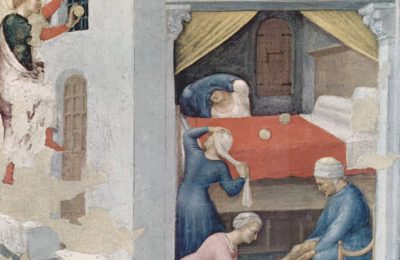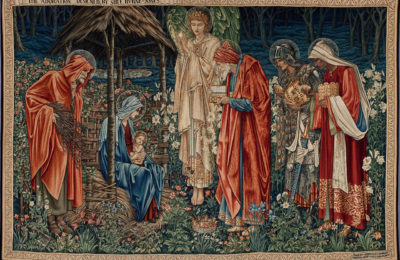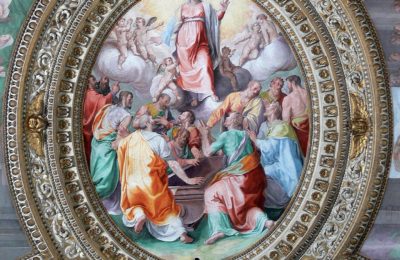Today, I am posting an excerpt from The Glories of Mary by St. Alphonsus Liguori* (b. 1696- d. 1787) where this Doctor of the Church teaches us that the Blessed Virgin Mary, from the moment of her Immaculate Conception, was filled with grace:
Justly, then, did David say, that the foundations of this city of God, Mary, should be laid upon the summits of the mountains: “Fundamenta ejus in montibus sanctis;” by which we are to understand that the beginning of the life of Mary was more exalted than the completed lives of all the saints put together. “The Lord loveth the gates of Sion,” the prophet continues, “above all the tabernacles of Jacob.” And David himself gave this as the reason, namely, that God was to make himself man in her virginal womb: Man was born in her: “Homo natus est in ea.” Hence it was fitting that God should give to this Virgin, even from the first moment be created her, a grace corresponding with the dignity of the mother of God.
Isaias foretold the same when he said, that in future the mountain of the house of the Lord, which was the blessed Virgin, should be prepared on the summit of all the other mountains, and therefore all the nations must hasten to this mountain, to receive the divine favors. St. Gregory explains this by saying: Yea, the mountain on the top of mountains, because the glory of Mary shone above that of all the saints. And as St. John Damascene expresses it: The mountain which it pleased God to choose for his habitation. Mary was called a cypress, but a cypress of Mount Sion: she was also called a cedar, but a cedar of Lebanon; an olive-tree, but a fair olive-tree; chosen, but chosen as the sun; for, as the sun, says St. Peter Damian, with his light so far exceeds all the splendor of the stars, that they are seen no more when be appears, so the great Virgin Mary surpasses, with her sanctity, the merits of the whole celestial court. And as St. Bernard elegantly expresses it: Mary was so sublime in sanctity, that none but Mary was a fitting mother of God. And no other Son than God was befitting Mary.
The second argument which proves that Mary, in the first moment of her life, was more holy than all the saints united, is founded upon the great office which she had from the beginning, of mediatrix of men; for which it was requisite that she should possess a greater treasure of grace than the whole human race together. It is very well known how universally this title of mediatrix is applied by theologians and by the very holy Fathers to Mary, since by her powerful intercession and merits de congruo she has obtained salvation for all, procuring for the ruined world the great blessing of redemption. It is said by merit de congruo, because Jesus Christ alone is our mediator by way of justice, and by merit de condigno, as it is expressed by the schools, he having offered to the eternal Father his merits, which he has accepted for our salvation. Mary, on the contrary, is the mediatrix of grace by way of simple intercession, and of merit de congruo, she having offered to God, as the theologians say with St. Bonaventure, her merits for the salvation of all men; and God, through grace, has accepted them in union with the merits of Jesus Christ. Hence Arnold Carnotensis says: She effected our salvation in common with Christ. And Richard of St. Victor, also: She desired, sought, and obtained the salvation of all; nay, more, the salvation of all was effected through her. So that every blessing and every gift of eternal life which each of the saints has received from God, has been obtained for them by Mary.
And it is this which the holy Church wishes us to understand, when she honors the divine mother by applying to her these passages of Ecclesiasticus: In me is all grace of the way and of the truth: “uln me gratia omnis vise et veritatis.” It is said: Of the way, because through Mary all graces are dispensed to those who are still on the road to heaven; Of the truth, because through Mary is given the light of truth. In me is all hope of life and of virtue: “In me omnes spes vitse et virtutis.” Of life, because through Mary we hope to attain the life of grace upon earth, and of glory in heaven; and of virtue, because through Mary virtue is obtained, and especially the theological virtues, which are the principal virtues of the saints. I am the mother of fair love, and of fear, and of knowledge, and of holy hope. Mary by her intercession obtains for her servants the gifts of divine love, of holy fear, of celestial light, and of holy confidence. And St. Bernard infers that it is taught by the Church, that Mary is the universal mediatrix of our salvation. “Extol the finder of grace, the mediatrix of salvation, the restorer of ages.” Thus the Church sings of her to me, and hath taught me to sing the same.
Therefore, as St. Sophronius, Patriarch of Jerusalem, asserts, the archangel Gabriel called her full of grace: “Ave gratia plena;” because whilst to others, as the saint above mentioned remarks, limited grace is given, to Mary it was given in fulness. And thus it was ordered, as St. Basil attests, that in this way she might become the worthy mediatrix between God and men. For if the Virgin had not been full of divine grace, as St. Lawrence Justinian adds, how could she be the ladder of paradise, the advocate of the world, and the true mediatrix between God and men?
“Ladder of paradise, advocate of the world, and true mediatrix between God and men,” pray for us.
•SCF
Image (above): perched in the Blue Ridge Mountains of Virginia, Our Lady of the Blue Ridge Catholic Church, Madison, VA; image taken by KBF on July 7, 2018.
*”Saint Alphonsus Liguori…was an Italian Catholic bishop, spiritual writer, composer, musician, artist, poet, lawyer, scholastic philosopher, and theologian. He founded the Congregation of the Most Holy Redeemer (the Redemptorists). A prolific writer, he published nine editions of his Moral Theology in his lifetime, in addition to other devotional and ascetic works and letters. Among his best known works are The Glories of Mary and The Way of the Cross, the latter still used in parishes during Lenten devotions. He was canonized n 1839 by Pope Gregory XVI and proclaimed a Doctor of the Church by Pope Pius IX in 1871. One of the most widely read Catholic authors, he is the patron saint of confessors.” source






